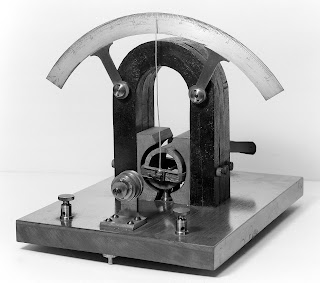These are instruments that are used in physics for various
circuit construction and experimental purposes. We cannot make circuits without
these apparatus and instruments. Learners must understand these apparatus
structure and construction.
Moving coil galvanometer
The moving coil galvanometer consists of a fine coil of wire
pivoted on jewelled points between the pole pieces of a powerful permanent
magnet. The movement of the coil is controlled by a fine spring.
A long light pointer is attached to the coil. The pointer
moves over a circular scale with a zero at the centre.
When a current is sent through the coil, it is deflected and
the pointer moves over the scale. The direction of motion of the pointer
depends on the direction of the current.
The extent of the movement is directly proportional to the
current. This galvanometer can measure very small currents of the order of
microamperes. This can be modified into an ammeter to measure currents in
amperes or into a voltmeter to measure potential differences in volts.
Ammeter
The ammeter is a modified form of moving coil galvanometer
designed to read current directly in amperes. The scale is graduated in
amperes. A moving coil galvanometer can be converted into an ammeter by
connecting a suitable low resistance across the terminals.
The two resistances connected in parallel across the coil of
the galvanometer are called the ‘shunt’. The ammeter is a low-resistance
instrument. It is always connected in series with the circuit, the current in
which is to be measured.
Voltmeter
The voltmeter is used to measure the potential difference
between two points in an electrical circuit. In construction, it is similar to
an ammeter, but it has a high resistance connected in series with the coil.
The voltmeter is graduated to read the Potential Difference
in volts. It should always be connected in parallel with the two points across
which the Potential Difference is required.
A moving coil galvanometer can be converted into a voltmeter
by connecting a high resistance in series with it.
Rheostat
The rheostat is an adjustable resistance used in electrical
circuits. It is used to adjust the current in the circuit by varying the
resistance. It consists of a porcelain tube over which is wound tightly with a uniform
resistance wire.
The current enters it at one end of the coil and leaves
through a sliding contact at another top end to which the other terminal is
attached. The resistance between the slider and the end where the current
enters is included in the circuit.
Resistance box
A resistance box enables a known resistance to be included in
a circuit. There are two types of boxes, plug type and the dial type. By removing
a plug or turning the dial, the required resistance can be introduced in the
circuit in which the box is connected.
Related Post:
Related Post:
Tags
technology





